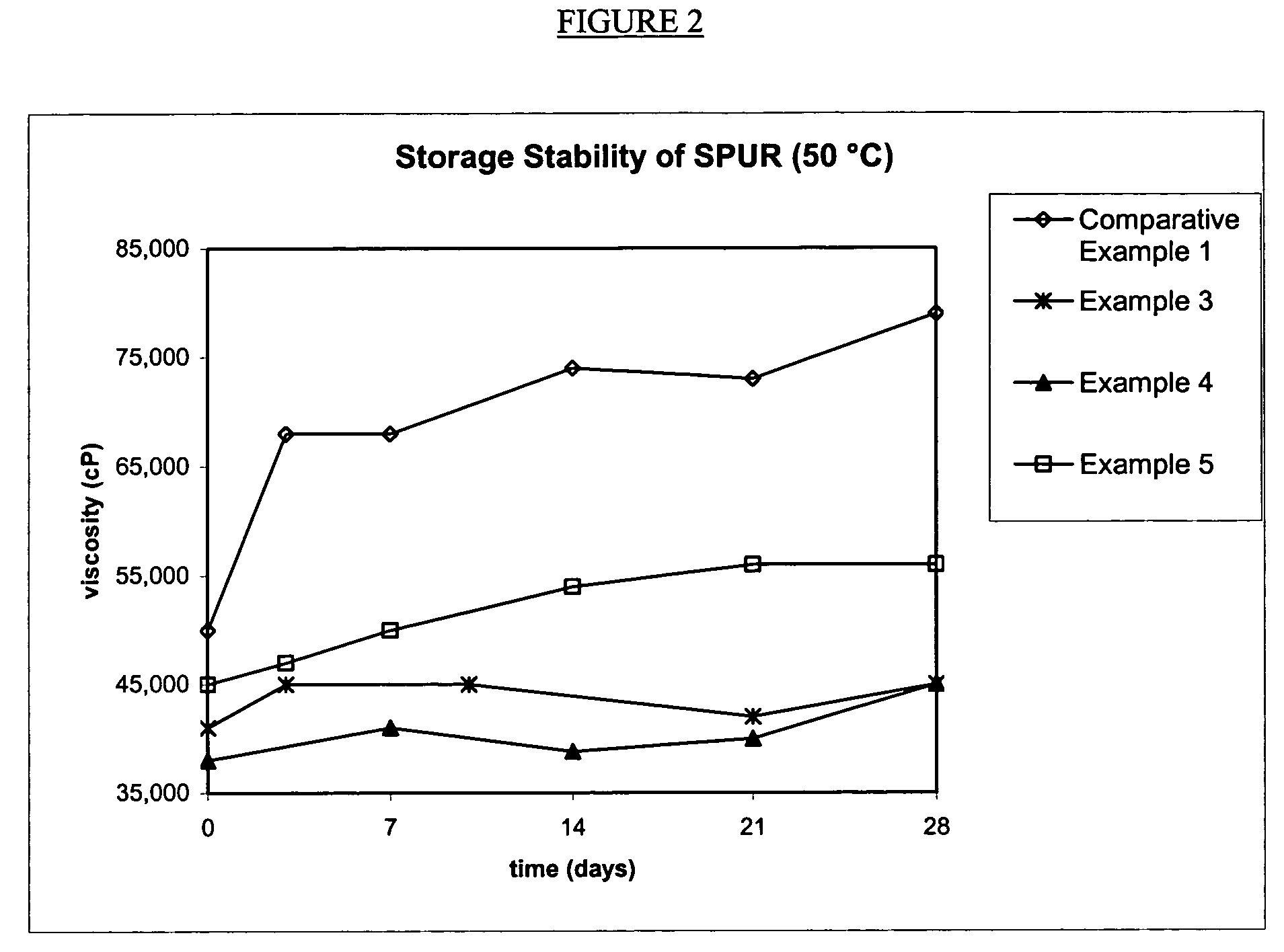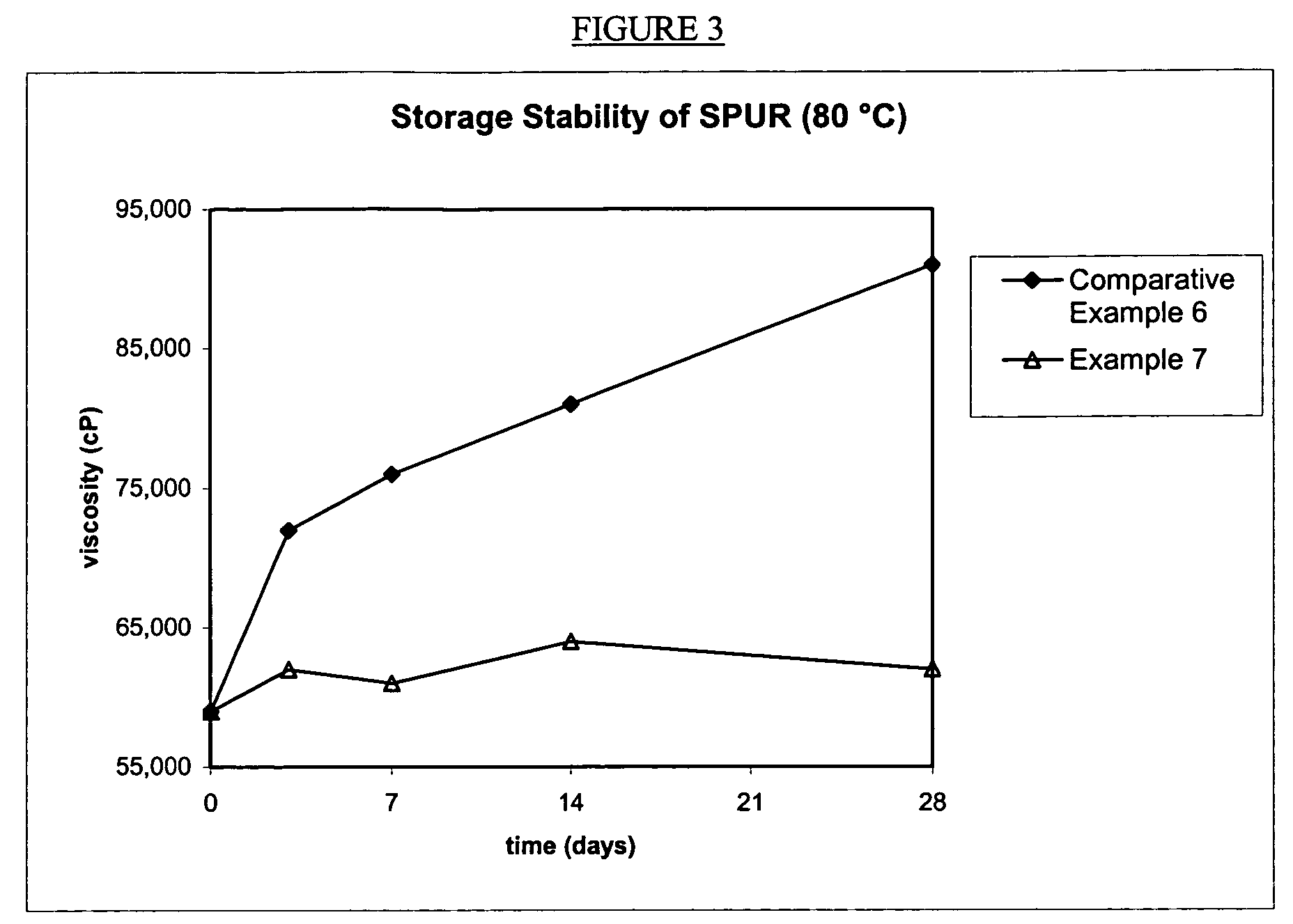Process for preparing a curable silylated polyurethane resin
- Summary
- Abstract
- Description
- Claims
- Application Information
AI Technical Summary
Benefits of technology
Problems solved by technology
Method used
Image
Examples
example 3
[0055]The silylated polyurethane resin with isocyanate-reactive scavenging agent was made by a batch process. Into a 22 L reactor were charged Acclaim® 12200N polyol (Bayer, OH# 10.2 mgKOH / g, 14600 g) and Irganox® 1135 (Ciba, 73 g). The mixture was sparged with nitrogen at 85° C. for 16 hours. While maintaining the reaction temperature at 85° C., sequentially were added 85% phosphoric acid (35 μL), isophorone diisocyanate (Bayer, Desmodur® I, 147.5 g) and dibutyltin dilaurate (General Electric Advanced Materials, Fomrez® Catalyst SUL-4, 7.77 g of a 10 wt % solution in di(propylene)glycol dimethyl ether). The mixture was reacted until the viscosity was 22,000 cP and the isocyanate concentration was 0.10%, at which point was added 3-isocyanatopropyltrimethoxysilane (General Electric Advanced Materials, Silquest® A-Link™ 35, 302.3 g). The reaction was continued until the reaction mixture reached viscosity 52,000 cP and isocyanate concentration 0.07%, when methanol (9.21 g, 0.06 wt %, s...
example 4
[0056]The silylated polyurethane resin with isocyanate-reactive scavenging agent was made by a batch process. Into a 22 L reactor were charged Acclaim® 12200N polyol (Bayer, OH# 10.2 mgKOH / g, 14600 g) and Irganox® 1135 (Ciba, 73 g). The mixture was sparged with nitrogen at 85° C. for 16 hours. While maintaining the reaction temperature at 85° C., sequentially were added 85% phosphoric acid (35 μL), isophorone diisocyanate (Bayer, Desmodur® I, 147.5 g) and dibutyltin dilaurate (General Electric Advanced Materials, Fomrez® Catalyst SUL-4, 7.77 g of a 10 wt % solution in di(propylene)glycol dimethyl ether). The mixture was reacted until the viscosity was 20,000 cP and the isocyanate concentration was 0.10%, at which point was added 3-isocyanatopropyltrimethoxysilane (General Electric Advanced Materials, Silquest® A-Link™ 35, 302.3 g). The reaction was continued until the reaction mixture reached viscosity 47,000 cP and isocyanate concentration 0.06%, when methanol (18.4 g, 0.12 wt %, s...
example 5
[0057]The silylated polyurethane resin with isocyanate-reactive scavenging agent was made by a batch process. Into a 22 L reactor were charged Acclaim® 12200N polyol (Bayer, OH# 10.2 mgKOH / g, 14600 g) and Irganox® 1135 (Ciba, 73 g). The mixture was sparged with nitrogen at 85° C. for 16 hours. While maintaining the reaction temperature at 85° C., sequentially were added 85% phosphoric acid (35 μL), isophorone diisocyanate (Bayer, Desmodur® I, 147.5 g) and dibutyltin dilaurate (General Electric Advanced Materials, Fomrez® Catalyst SUL-4, 7.77 g of a 10 wt % solution in di(propylene)glycol dimethyl ether). The mixture was reacted until the viscosity was 27,000 cP and the isocyanate concentration was 0.07%, at which point was added 3-isocyanatopropyltrimethoxysilane (General Electric Advanced Materials, Silquest® A-Link™ 35, 302.3 g). The reaction was continued until the reaction mixture reached viscosity 57,000 cP and isocyanate concentration 0.05%, when a mixture of methanol (18.4 g,...
PUM
| Property | Measurement | Unit |
|---|---|---|
| Fraction | aaaaa | aaaaa |
| Fraction | aaaaa | aaaaa |
| Percent by mass | aaaaa | aaaaa |
Abstract
Description
Claims
Application Information
 Login to View More
Login to View More - R&D
- Intellectual Property
- Life Sciences
- Materials
- Tech Scout
- Unparalleled Data Quality
- Higher Quality Content
- 60% Fewer Hallucinations
Browse by: Latest US Patents, China's latest patents, Technical Efficacy Thesaurus, Application Domain, Technology Topic, Popular Technical Reports.
© 2025 PatSnap. All rights reserved.Legal|Privacy policy|Modern Slavery Act Transparency Statement|Sitemap|About US| Contact US: help@patsnap.com



